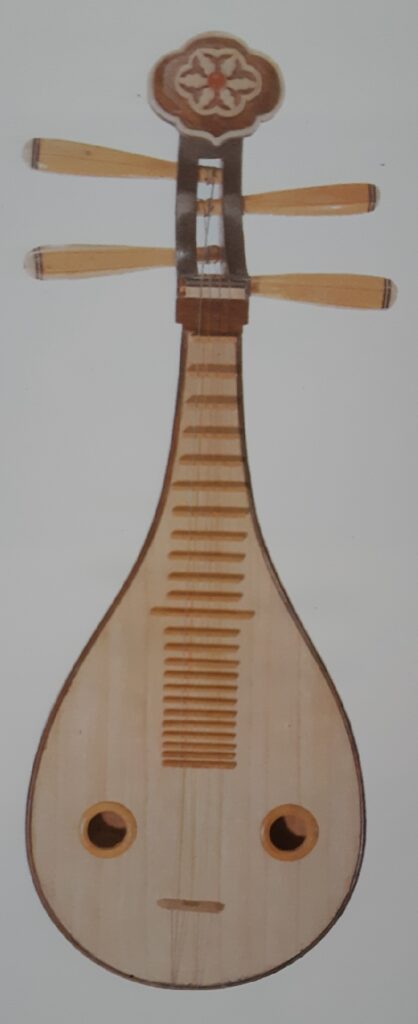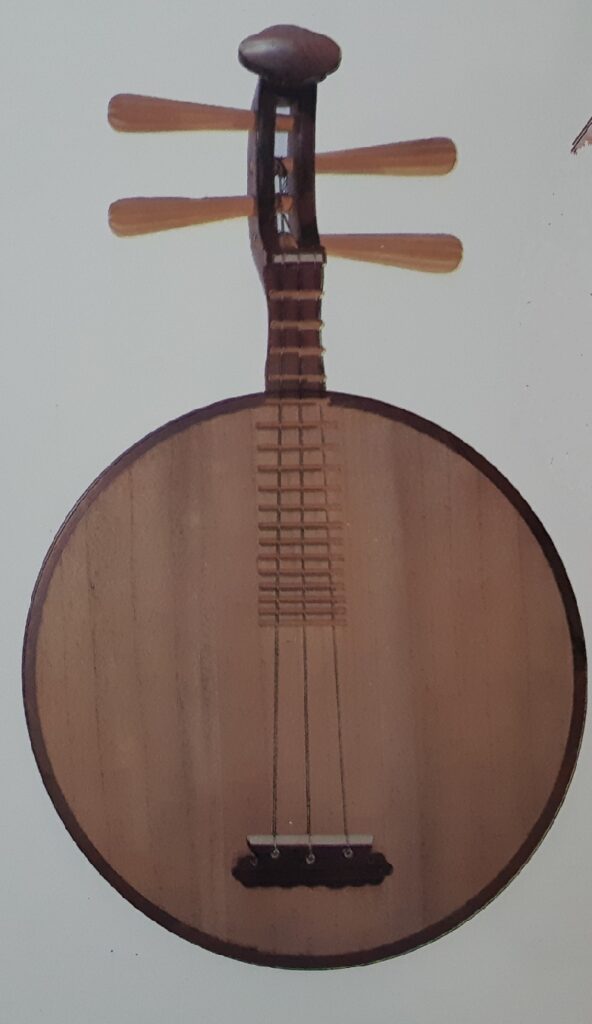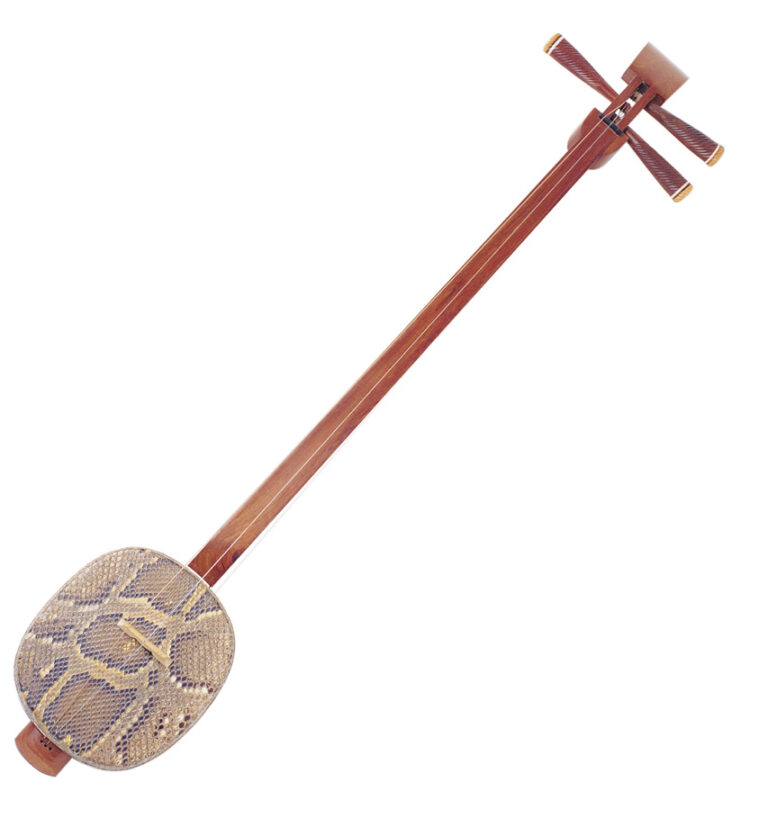中國民族音樂資料館 Chinese Music Archive
彈撥類 Plucked String Instruments
古琴 - Guqin
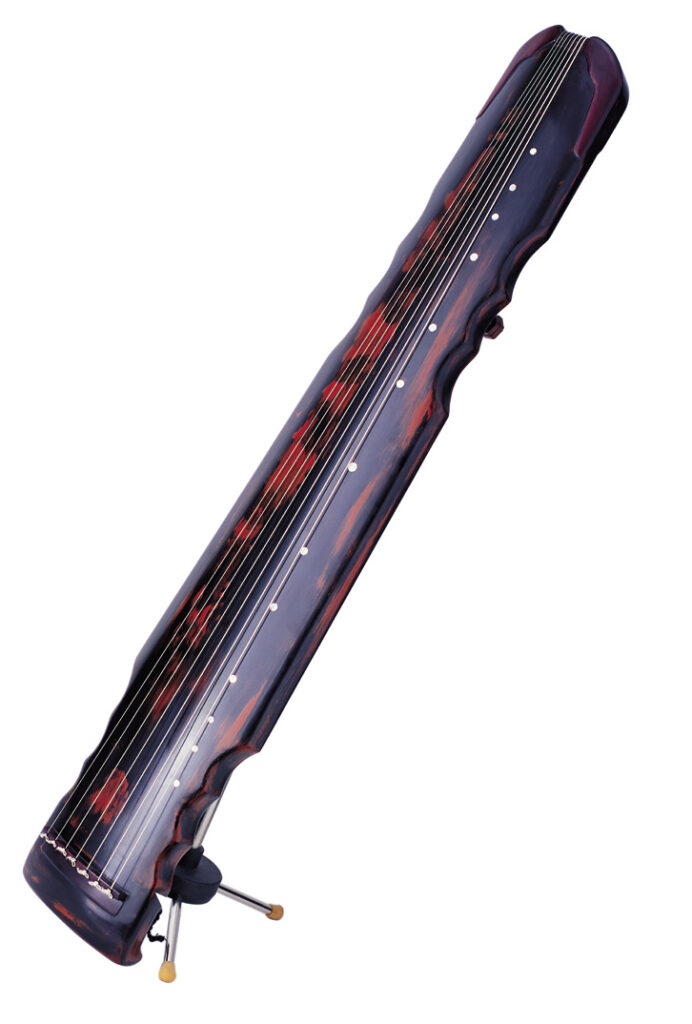
古琴,亦稱「七弦琴」,史籍中多稱「琴」。唐詩有「泠泠七弦上,靜聽松風寒」之名句,「泠泠七弦」指的就是古琴。春秋擂鼓墩墓與西漢馬王堆墓出土的「琴」更證實了它的歷史之長久,《詩經》、《尚書》等古籍和唐宋詩詞中也常常見到有關「琴」與琴樂的記敘。所以,古琴是中國歷史十分悠久的一件民族樂器。至今大型博物館內和琴家私人收藏中還能見到唐、宋、元、明、清年代的古琴。
古琴由狹長的一塊桐木面板(也有用其他松質木材)和一塊梓木底板(也有用其他硬質木材)膠合而成,外表髹以中國大漆。琴面外側嵌有十三個小圓點的「徽」,為泛音和按音音位的標誌。琴面繫弦七根,外側至內側由粗至細,橫置於琴卓上演奏。與很多樂器相比較,古琴有如下獨特之處:古琴弦的有效振動弦長超出一般樂器的弦長,振幅寬大,音質低沉渾厚,幽靜古樸;古琴的面板即指板,無品無柱,出音孔開於底板,向下傳音;琴上存有一百多個實用的泛音,堪稱樂器之最。
在一千五百年以前古琴曲《碣石調‧幽蘭》已由專用的記譜法——「文字譜」記成並流傳至今。唐朝時又將文字譜改進為「減字譜」,經千餘年傳衍。歷代琴家編簒刋印了一百五十餘部琴譜譜集,其中共收錄了三千餘首琴曲和琴歌,以及大量的理論文字篇章。古琴音樂的遺產蔚然大觀,浩如煙海,可謂是中國民族音樂中的瑰寶,已引起海內外音樂史家、音樂理論家的重視。
古琴音樂的「打譜」
古琴音樂的「打譜」,是對大量記載在古琴譜集中的久已失響的琴曲進行譯譜、整理、考證、鑒別以及表演性的再創作等多種因素的一項綜合性的音樂活動。
打譜者必須要對所打譜的琴曲的時代、作者、各種版本、歷代琴家的評述以及歷代記譜法的沿革有較詳實的深入研究,盡可能地忠實於歷史,並通過演奏,還原原曲的風貌。此項音樂活動仔細而繁雜,故有打譜一首琴曲需費時「小曲三月,大曲三年」之說。
Guqin (Ancient Zither)
Guqin, also called “Seven-stringed Zither”, was rendered as “qin” in most ancient writings. The discovery of the remains of the qin in ancient tombs (500 to 200 B.C.), together with the description of the qin and its music in many ancient writings assured us of its long history. Today, qins of the Tang Dynasty (700 A.D) up to the Qing Dynasty (19th Century) still exist in museums and in collections of modern qin players.
The qin consists of a long, narrow upper wooden board made from tong tree (or other trees of the pine family) and a lower board made from catalpa tree (or other hardwood). These two pieces of boards are stuck together and lacquered on the surface. There are 13 small dots (call hui) inlaid on the outside of the upper board, which mark the positions of the musical notes and their harmonics. Seven strings are fixed on the upper board, starting from the thickest one on the outside to the thinnest one on the inside. When played, the qin is put on a table.
When compared with other instruments, the qin is special in the following aspects:
- The effective vibrating length of the strings of the qin is longer than that of other instruments, resulting in a large vibrating amplitude and a tone rich in the lower register which fits in with the sounds of the nature.
- The fingerboard of the qin is the upper board which does not consist of any frets. Sound holes are opened on the lower board, which means that the sound is transmitted downwards.
- Over 100 overtones (harmonics) can be played on the qin. It is probably the instrument which has the largest number of overtones.
1500 years ago, music for the qin was recorded by words, which were called “Literal scores”. During the Tang Dynasty, “Simplified scores” were developed and used from then on instead of the “Literal scores”. Over the centuries, qin players published over 150 books on qin music, which included over 3,000 pieces of music for the solo qin or songs with qin accompaniment, and also plenty of articles on theories about the qin. The legacy of qin music is so rich that it is now considered as the gem of Chinese traditional music and catches the attention of experts on music history and musicologists around the world.
Transcription of Qin Music
Transcription (dapu), in qin music, means interpreting, arranging, examining, differentiating and re-creating, for performing purposes, the large number of pieces of music for the qin recorded in ancient documents.
The person who does the transcription of a piece of qin music must have an in-depth research on the period, composer, different versions of the piece, descriptions of the piece by qin players over the centuries and the development of scoring methods of the qin. He tries his best to be faithful to history and recovers the original sounds of the piece through performing it. It is a complicated and tedious task. It has been said that it took “three months for a small piece, and three years for a large piece”.
琵琶 - Pipa

「琵」和「琶」原是兩種彈奏手法的名稱,琵是右手向前彈,琶是右手向後彈。秦、漢至唐一段時期,琵琶二字曾作為多種彈弦樂器的總稱。那時候,不管琴杆長的、短的,圓形音箱的、梨形音箱的,木面的、皮面的,弦數多的、弦數少的,橫著彈的、豎著彈的,凡是奏法相似的,一律稱為琵琶,而不是某個樂器所專用的名稱。到了宋代,才開始使琵琶這一名詞,由廣義變為狹義,專用於稱呼梨形音箱的曲項琵琶。
秦、漢時,出現了兩種琵琶。約在公元前二一四年,我國人民參考鼗(tao)鼓的形制創造出一種直柄、圓形音箱、兩面蒙皮,用手彈撥的樂器,叫做弦鼗,又名琵琶,約在公元前一○五年,我國人民又參考了箏、築、箜篌等樂器,創造出一種木制直柄,圓形音箱,有四根弦,十二柱,豎抱著,用手彈撥的樂器,也稱之為琵琶。後人稱這種琵琶為秦琵琶。晉阮咸以善彈此樂器聞名,故又稱之為阮咸,簡稱阮。
約在四世紀(約公元五三○年左右),有一種曲項琵琶,通過印度傳入中國的北方。公元五五一年以前,又傳到南方。它適應我國歌舞藝術的發展,在隋唐時代大大地盛行起來,被視為當時重要彈弦樂器之一,唐代大曲常用它來領奏。琵琶除了作為獨奏樂器以外,也用於伴奏歌曲、歌舞、曲藝、戲曲及器樂合奏。
現在的琵琶,吸取曲項琵琶的形式,結合秦琵琶的優點改革而成。原先外來的曲項琵琶是木質梨形音箱,曲頸、四弦、四柱(即相位,沒有品位),用撥子彈奏。經過我國人民在長期實踐中不斷進行改革,吸取了阮多柱、手彈等優點,發展為十四個柱,由橫彈改為豎彈,由撥彈改為手彈。在形制上,在音域上,在演奏效果上,已與原先的曲項琵琶大不一樣。新中國成立後,琵琶又有了更大的發展,由絲弦改為鋼絲弦,或尼龍纏鋼絲弦;增加為三十一個柱(六相二十五品),有十二個半音,可轉十二個調;擴大了音域和音量,音色明亮,提高了琵琶的表現力。
Pipa, was originally referred to two plucking techniques “pi” and “pa” for all the plucked string instruments in East Han Dynasty period. These were the right hand techniques, pi was played in forward direction and pa was played in opposite direction. At that time, all of the plucked string instruments were then began to be called “pipa”. Around the fourth century (around 530 AD), a kind of pipa, shipped to China through northern India. Then it was widely spread to the southern part of China and well developed in Sui and Tang Dynasty. In addition to being a solo instrument, pipa also used for accompaniment of songs, dance, opera and always used in instrumental ensembles. After a long development period, the imported pipa has ongoing reformed to a pear shape instrument with four strings, use fingers instead of pick for plucking and changed the performing style from horizontal to vertical. The substance of the strings has also changed from silk to nylon and steel.
古箏 - Guzheng
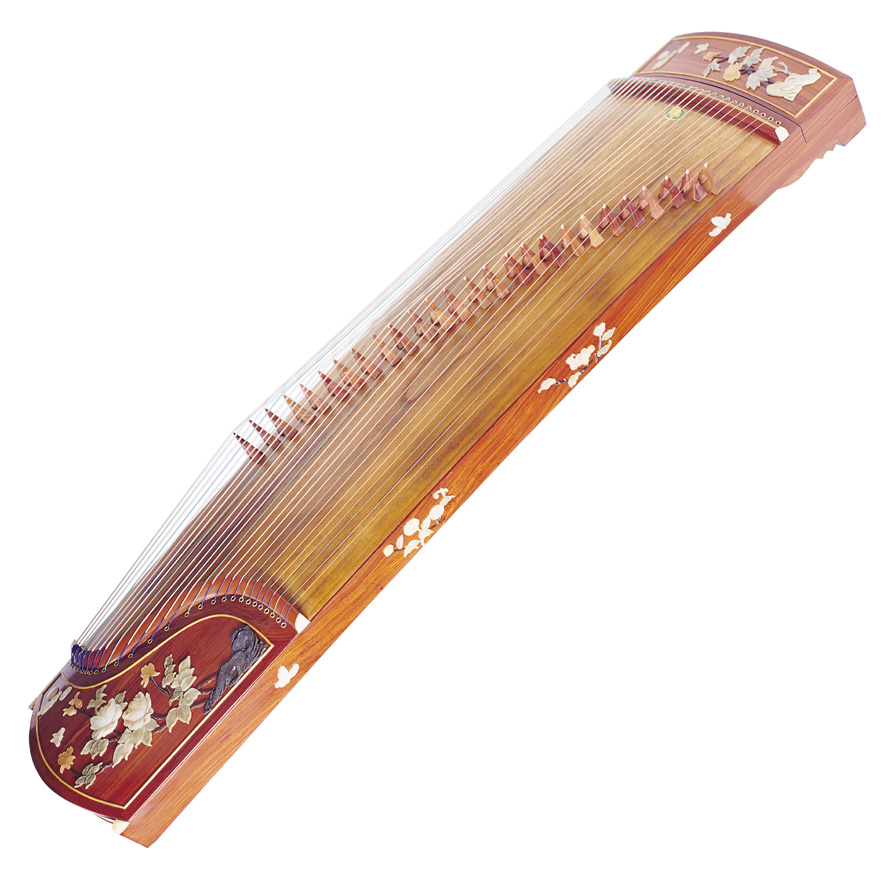
古箏原稱箏,是我國比較古老的民族樂器之一,遠在戰國時代(公元前四○三至二一一年)就流行於當時的秦國(現在的陝西省)境內了,所以有「秦箏」的名稱。
從我國古代歷史材料裏,和古代文人的詩、詞、歌、賦裏,都可以看出它不但是廣大勞動人民所喜聞樂見的東西,並且也是為熱愛這種樂器的勞動人民所掌握著的。《史記‧李斯諫逐客書》裏所說的:「彈箏搏髀……真秦之聲也」和《漢書》《鹽鐵論》裏所說的「往者民間酒會各以黨俗,彈箏鼓缶而已」。就可以證明這一點。
若再從漢侯瑾、魏阮瑀、晉賈彬等人的《箏賦》和唐人白居易、李白、張九齡等人的《詠箏詩》,以及宋人歐陽修、晏兒道等人的《詠箏詞》的描寫中,便也可見到箏在民間音樂中的地位。
箏雖然是發源於古代秦國地方,但因歷史的變遷,它已經逐漸成為河南、山東、廣東、雲南、浙江等地的地方樂器;而在今天,在文藝路線和改革出新下,它已經得到更大的推廣和發展,所以說它不僅是上述少數地區的民間樂器,而是有悠久歷史的民族樂器。
箏的音箱是用梧桐木刳鑿成長方形音箱,面板呈弧形,弦張在面板上,過去各地流行的箏,或用蠶絲弦,或用銅絲弦,弦數由十二到十六不等,每弦一個撐弦碼子,稱「雁柱」,用以調節弦長,固定音高,一般是按五聲音階定弦排列;音箱底部平坦,設音孔二,稱為「越」。傳統的演奏技法是用右手大、食、中三指彈弦取音,可用肉甲或義甲撥弦,左手食、中、名指捺弦,可奏出按、顫、揉、推等變化音,近年來,這些基本技法又已作了新的發展。
新中國成立後,箏有了很大的改革,一般使用了鋼絲弦或尼龍包鋼弦,並增加了弦數,現已有十九弦、二十一弦、二十五弦等多種,有些品種設有機械變音裝置,能轉十二個調,改革後的箏,音域擴大,音量增加,表現力豐富。
–Guzheng
Guzheng is also called zheng. It is one kind of the oldest Chinese traditional musical instrument. Upon the Warring States period (403 – 211 B.C.), it was most popular in Qin territory (now Shaanxi province). So it was also called “Qin Zheng”.
According to the historical records from the poetry and other writings, they told us that the instrument was beloved by the public and most people could manage it. It also reflected the importance of it in the civil through music history.
Although zheng was originated from Qin territory, it was gradually spread to Henan, Shandong, Guangdong, Yunnan, Zhejiang provinces and became their civil instruments. Today, zheng has been greater developed and is one kind of the traditional musical instruments among the people in China.
The sound box of the instrument is made by a long wooden board from tong tree. On the upper arch-shade side is load with strings across the separate bridges. In the past, the strings were made with silk, or bronze. Nowadays, they are made with steel and nylon. And the number of strings has developed from twelve to twenty five. On the lower flat side, there are two sound holes. The smaller one near the head of the instrument is used for affixing the strings. While the bigger one in the middle is used for the sound to transmit downward.
揚琴 - Yangqin
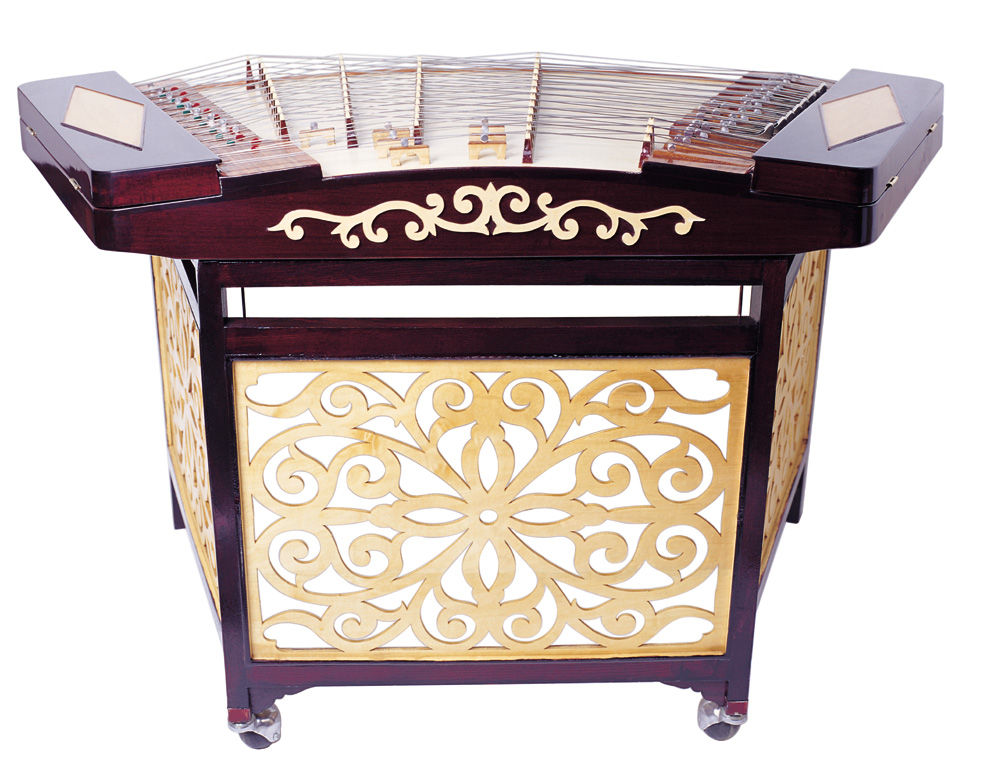
揚琴,相傳在明代(公元一三六八至一六四四年)傳入中國,最初流行於廣東一帶,現已流行全國。常用於戲曲、曲藝的伴奏,也用於合奏及獨奏。
揚琴音箱木質梯形,上張若干根鋼絲弦,奏時用竹槌敲擊發聲,音色清亮,可以奏兩組以上的音。
新中國成立後,揚琴有了進一步的發展,加大了琴身,增加了弦數,擴大了音量和音域,能奏出有十二個半音的四組音,可以轉調。音色清脆、嘹亮,可獨奏、伴奏和合奏。
Yangqin also known as the Dulcimer was delivered to China since the Ming dynasty (1368-1644 A.D.), it was initially popular in Guangdong province and later on spread widely to other provinces. It was mostly used as the accompanied instrument of various operatic music, folk singing and talks. After development, it was also used for solo and ensemble music. It has a wooden ladder shape sound box which is mounted with strings over the bridges. It is performed with bamboo strikers and has a clear and melodic tone colour. It can be played up to more than two octaves in the scale. Nowadays, it is developed on the size and the number of string and bridge. It can be played four octaves in chromatic scale.
柳琴 - Liuqin
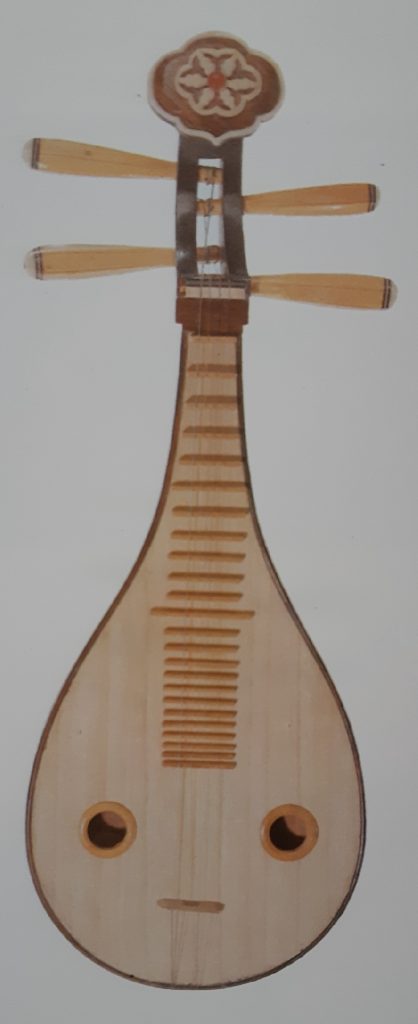
柳琴,因它形狀像柳葉,所以叫柳琴或柳葉琴。是蘇北魯南一帶的柳琴戲及安徽泗洲戲的主要伴奏樂器。
原來的柳琴是二弦,七品,絲弦,用撥子彈奏。新中國成立後,對柳琴進行了多次改革,製成了高音柳琴,將二弦七品改為四弦二十四品,依半音排列,擴大了音域,便於轉調;又改絲弦為尼龍弦,增大了音量,使音色更加優美。高音柳琴豐富了民族樂隊彈弦樂組的高音部。
Liuqin is so called, because it has a willow-leaf shade sound box. It is an instrument of the operatic music spread along the northern Jiangsu, southern Shandong and Anhui. The original liuqin has only two strings, seven frets and use a plectrum to pluck on the silk strings. Nowadays, it is developed to have four strings and twenty four frets in chromatic scale. The silk strings are reformed to steel-nylon strings. It is now the chief soprano plucked instrument of the ensemble.
月琴 - Yueqin
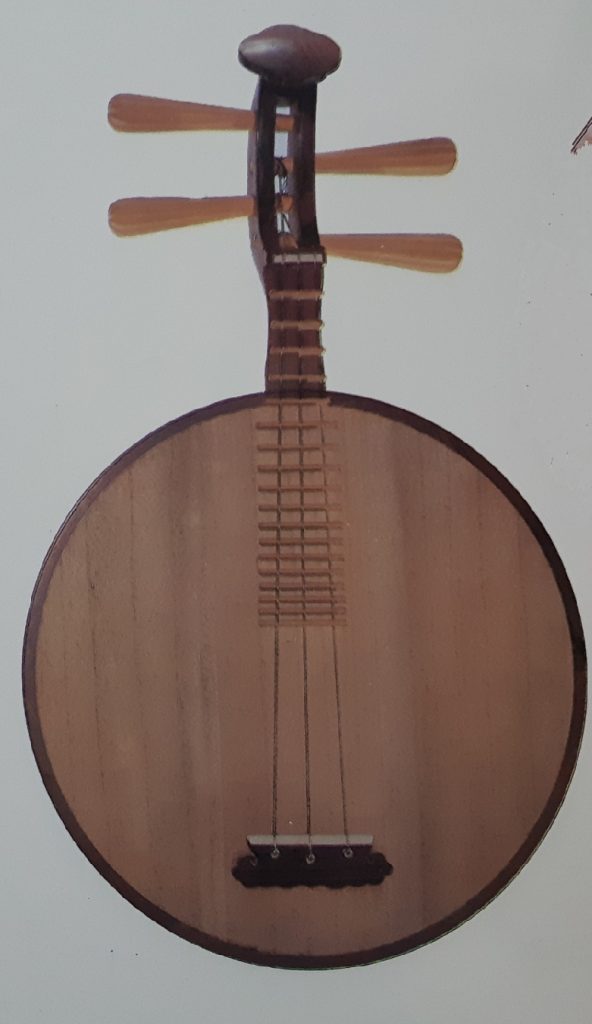
月琴是由阮衍變而成,在民間流傳很廣,常用於戲曲、曲藝伴奏及獨奏、器樂合奏。在京劇中,與京胡、京二胡一起稱為三大件。西南彝族稱月琴為弦子,常用以邊彈邊舞。
月琴的音箱,一般是木質圓形,也有八角形的,張四根絲弦,分成兩組,每組兩弦的音高相同,七品。音色清亮。通常是五度定弦,用撥彈奏。
新中國成立後,對月琴進行了改革。有一種改革後的月琴,加寬了琴頸;品位增多至二十四品,按半音排列,便於轉調;弦改為鋼絲尼龍纏弦。音色清脆、柔和。
Yueqin is developed from the ancient instrument called ruan. It is widely spread in many districts and be used as the accompanied instrument of various operatic music, folk singing and talks. After development, it was also used for solo and ensemble music. In the Beijing Operatic Music, it is used together with the jinghu and jingerhu to form the “Three Majors”. In the Yi minorities of the south-west district, their yueqin is called the xianzi. In general, the sound box of the yueqin is a wooden round shape one, we can also find some octagons. It has seven frets and four silk strings in two groups of perfect fifth. Each group has two strings tuning in the same pitch. Nowadays, it is reformed to have twenty four frets in chromatic scale and the silk strings have changed to steel-nylon string.
三弦 - Sanxian
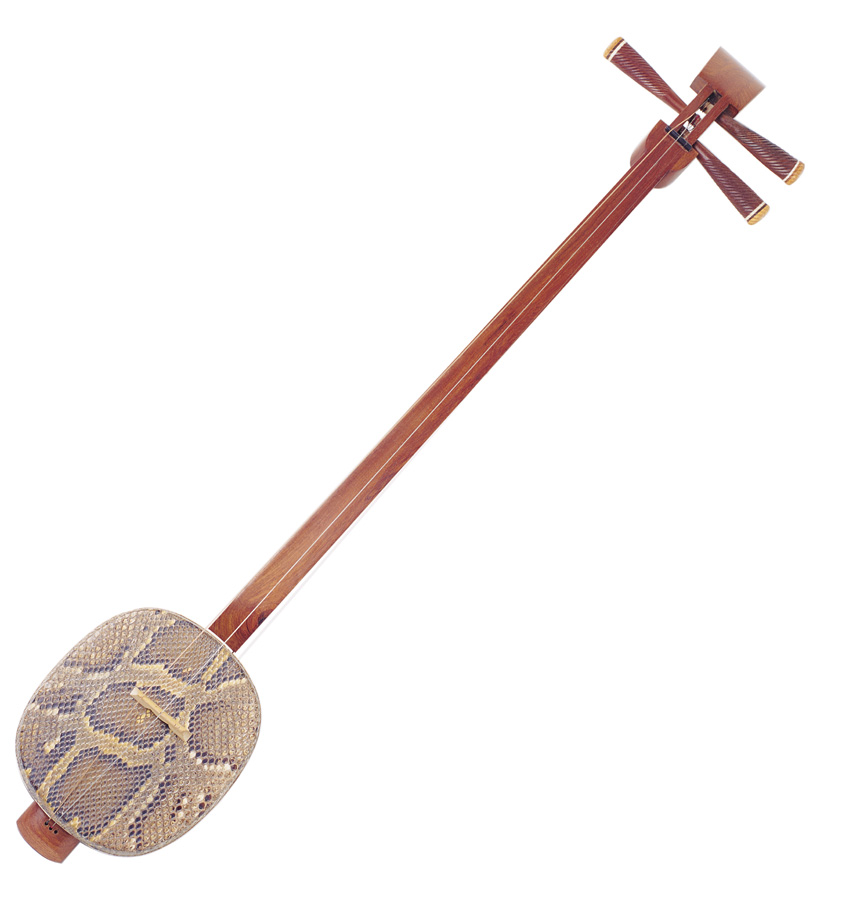
三弦,又名弦子。它的前身可能是秦代的弦鞀。到了元代(公元一二八○至一三六八年)才有三弦之名。
漢族和某些少數民族,都有三弦。漢族的三弦有橢圓形木質、兩面蒙皮的扁平鼓頭(即音箱),以琴杆為指板,無品位。
約在十九世紀中期,直隸(現在的河北省)高陽縣木板大鼓說唱藝人馬三峰,又根據小三弦的形式,創造了大三弦,受到當時北方說唱藝人們的歡迎。從此以後,大小兩種三弦,同時流行。特別在伴奏說唱音樂方面,形成南北不同的風格。小三弦一名曲弦,音色清亮,用於昆曲、彈詞等戲曲和說唱音樂的伴奏,以及十番鼓、十番鑼等器樂合奏。大三弦,又名書弦,音色寬宏低沉,一般用於北方大鼓書、牌子曲等音樂的伴奏。
–Sanxian
Sanxian is also called Xianzi and is developed from the xiantao of the Qin dynasty. It was named sanxian since the Yuan dynasty (A.D.1280-1368). It is widely spread in Han nationality and certain minorities. The Han one has a wooden ellipse shape sound box covered with skins in both sides. The long stem (handle) is the finger broad with no frets on it. Around the mid-nineteenth century, the artist MA San-feng of Gaoyang, Heibei province, reformed the small sanxian and initially develop the large sanxian which was well received by the northern artists. Since then, two kinds of sanxians spread simultaneously and formed the music style of north and south. Small sanxian was then call quxian and be used in the southern China. Large sanxian was then call shuxian and be used in the northern China.
阮 - Ruan
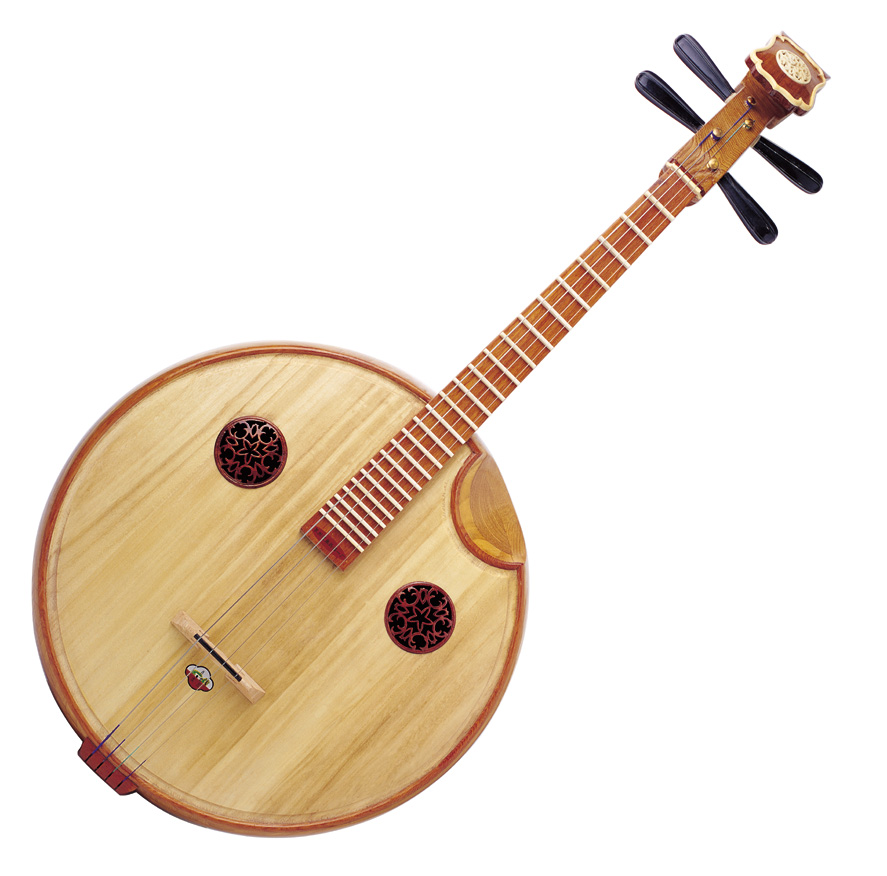
阮,漢武帝時(公元前一四○至八七年),我國人民參考了箏、筑、箜篌等樂器創制而成的彈撥樂器。阮,圓形音箱,直杆,四根弦,有十二個柱位,每個柱位橫貫於高低不同的四根弦之間,為四弦所共用。這樣的構造說明我國對平均律的使用於此時開始。阮在當時稱為琵琶。後人稱為秦琵琶或月琴。到唐代已有十三個柱位,唐武則天時,才改稱阮咸,近代稱為阮。後來的阮,有張四根弦的,也有張三根弦的。柱位也比漢代有所增多。
新中國成立後,對阮進行了一系列改革,在形制上有小阮、中阮、大阮、低阮四種,品位增加到二十四個,擴大了音量,音色更為柔美。在器樂合奏及伴奏裏,阮成為重要的彈撥樂器之一。一般常用的有大阮和中阮兩種。
Ruan is a kind of plucked instrument derived from zheng, zhu and konghou since Han dynasty (140-87 B.C.) It bears a round wooden sound box and a long stem which has four strings and twelve frets. It was called pipa at that early time. Later on, it was renamed qinpipa or yueqin. At Tang dynasty, it was developed to have thirteen frets and be called ruanxian. It is now generally called ruan and mostly has three to four strings with frets in chromatic scale. Nowadays, it has developed into xiaoruan, zhongruan, daruan and diruan. Each of that bears twenty four frets and become a set of plucked instruments in the ensemble. The zhongruan and daruan are commonly used in solo, accompaniment and orchestral work
秦琴 - Qinqin
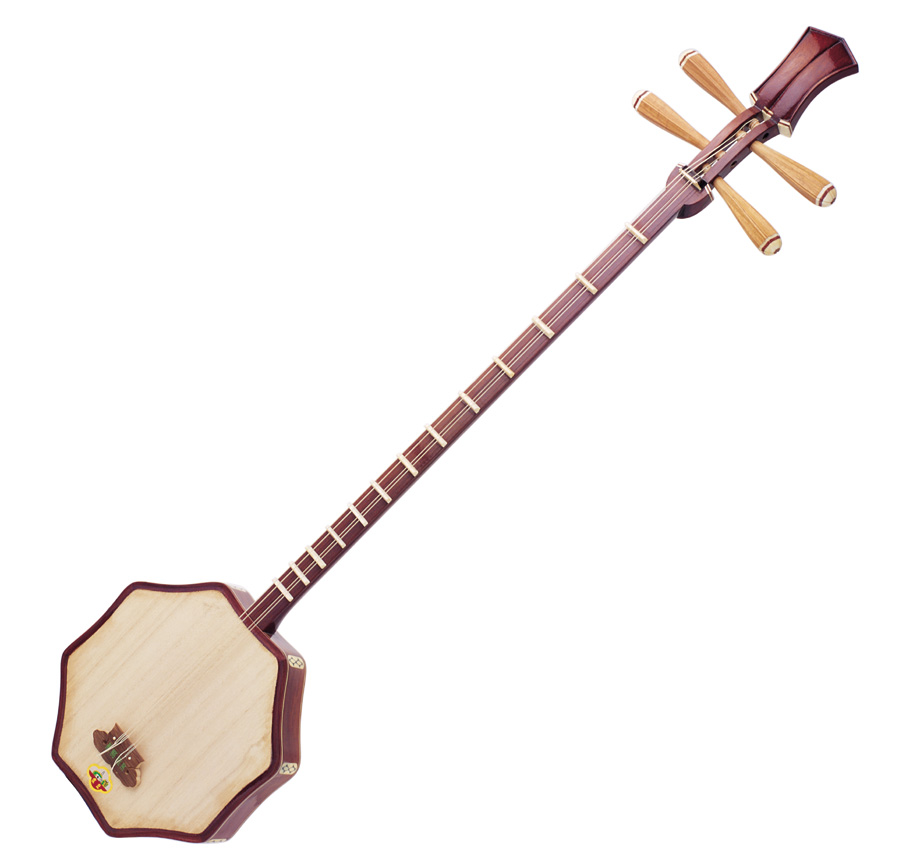
秦琴,是由古代的「阮咸」發展衍變而成。「阮咸」相傳乃竹林七賢之一的阮咸所創制。據《國史篡異》和《事物原始》等書籍記載,有人破古墓發現一件帶長柄而體圓的十三品柱樂器,疑為阮咸所作,遂以木仿製,並將之稱為「阮咸」。千百年來,流傳各地,因生㓉習慣和演奏傳統,各地不一,式樣尺寸,長短厚薄,都發生了很大變化。
秦琴,彈撥樂器,現代型制稱六瓣的為「梅花秦琴」,以檀木為體,桐板作面,設覆手,配三弦,柄設十七品。
「梅花秦琴」原出潮州的二弦樂器「雙清」,二十世紀二十年代後,被廣府音樂家改制,配用三組較粗的弦,使成中音樂器。常用於廣東音樂合奏中,遂成廣東的特性樂器。
Qinqin is developed from the ancient instrument called ruanxcian. According to the historical materials, ruanxian was firstly introduced by RUAN Xian of the Seven Sages of the Bamboo Grove in the third century. After few centuries, it was rediscovered and widely spread in many districts with alternative developments.
Nowadays, qinqin is developed into a six-segment shade form called meifa qinqin. It is a plucking instrument with wooden sound box like yueqin, bearing a long stem with 17 frets and three strings.
Meifa qinqin is formerly derived from Chaozhou two-string instrument called shuangqing and be transformed to an alto instrument with three strings by Cantonese musicians in early twentieth century. It is later widely used in Cantonese music performing and become a model instrument.
箜篌 -Konghou
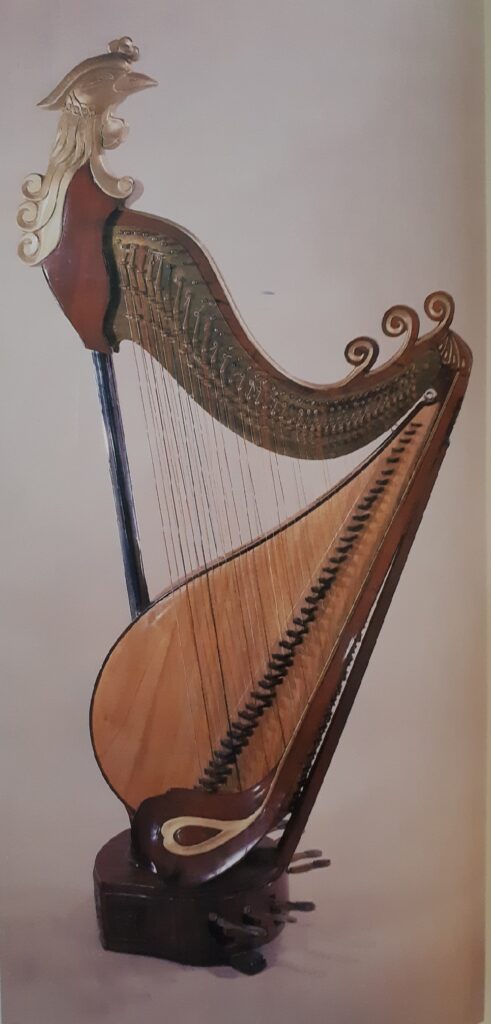
箜篌是撥奏弦鳴樂器,中國古代曾先後出現臥箜篌、豎箜篌、鳳首箜篌三種形制。
以上三種形制的古代箜篌均已失傳。二十世紀三十年代上海大同樂會曾有複製箜篌的嘗試,製作了大、小箜篌和鳳首箜篌,但未能推廣。從二十世紀五十代末期起先後有數種試製箜篌的設計方案。其中雁柱箜篌是較成功的一種。它是從七十年代開始,由專業音樂學者和樂器製作工人結合,借鑒了豎琴的某些特點並參考我國民族樂器的製作原理重新研製而成的。雁柱箜篌以古代豎箜篌造型為基礎,其共鳴箱不似原豎箜篌設在向上彎曲的曲木上,而是以側面琵琶形狀製成雙面立式共鳴箱,在共鳴箱上利用古箏的壓振原理做了雙排導音碼,並在共鳴箱後裝置了雙排弦揉音壓顫的機件。琴體由琴座、琴柱、弦軸板、立式共鳴箱(桐木制)、雙排導音碼、壓顫機件、鳳頭、音孔等部分組成。琴高一米七八,重四十公斤,七十二弦(三十六組同度弦),七聲音階排列,音域a1-b3(按顫音的音域為C-c3),用於獨奏、伴奏和合奏。
–Konghou
Konghou is a kind of plucked instrument which had three designs the horizontal, the vertical and the Phoenix head in the ancient times. These three kinds of konghou had already failed to pass down to us. In 1930s, Shanghai Ta Tung National Music Research Institute has copied it from the old design, but cannot popularize. In 1970s, scholars and manufacturers based on the distinguishing features of the harp and the characteristics of the traditional instruments developed a new kind of konghou. This new instrument bears seventy two strings in heptachord. Its range is a1-b3 and is commonly used for solo, accompaniment and orchestral works.


